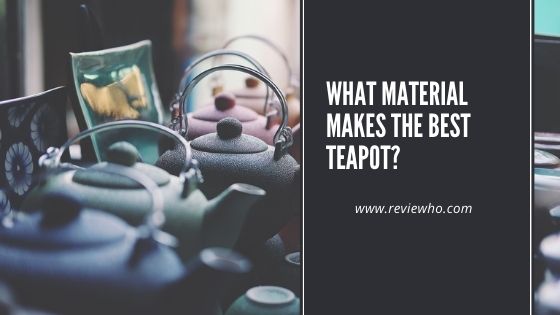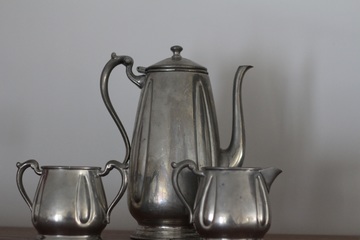One thing you will need to do if you love tea is to choose important tools such as cups, utensils, storage tins, kettles, and finally, a teapot. What choices do you have? There is an amazing range of teapots with different sizes, shapes, as well as amazing decorations. Sometimes these will prevent us from looking into the most important aspect, which is its function.
When purchasing a teapot, the first thing you should consider before making a purchase is the size, which will be anywhere between one and six cups, sometimes more. The next, most important thing you should think about is the material.
Teapots are created to perfection using different types of materials. So, which is the best teapot material? To be honest, no teapot is perfect in all aspects, which is why different options are available. Each of the material options in the market has a set of advantages and disadvantages.
This post guides you through all materials used to make teapots to help you identify what you would want for your kitchen.
Different Teapot Types
If you ask most people, you will find out that people assume that bone china, with a classic white appearance, is the only material used, which is not the case. So, what kind of materials are used for teapots?
Glass Teapots

In most cases, you will find glass teapots that are microwavable. Most of them are also dishwasher safe.
So, if you tend to take tea daily, it is a perfect choice for your kitchen. However, there is a downside associated with glass teapots. Glass teapots will lose heat quickly. A glass teapot is a perfect choice if you are looking for one to brew with. Additionally, it will make an amazing teapot if you want to enjoy the beauty of tea leaves producing the taste we all love.
These teapots are available in a range of sizes and shapes with different additional decorations you will love. You can find a glass teapot that does not have a filter. Those that do usually have metallic or glass filters.
The main advantage associated with glass teapots is the pleasure of viewing the brewing process. That fact also makes them great for cocktails.
In regards to the disadvantages, you will realize that it can be quite easy to note any stains. That is why you have to ensure they are always spotless.
Note: There are also colored glass teapots in the market you would enjoy.
Cast Iron Teapots

Cast iron teapots have been in the market for a couple of hundred years and are still widely used in our society. The reason why they are used extensively is that they are suited for the Western brewing conventions. They are usually large and their heat retention capabilities are amazing. When an infuser basket or bagged tea is used, they can be removed to manage the brew’s strength. The tea will also remain adequately hot so that you can enjoy more than a single cup.
Their use is especially preferred for cafes and restaurants, mainly because they are durable and are pleasant to the eye.
The current models of cast iron teapots are not like the traditional tetsubin. The traditional tetsubin was placed on charcoal stoves to heat water and is still widely used by serious tea enthusiasts. They are known to improve the quality of water. However, they are still hard to maintain and use. Contact with water makes them prone to rust and there are dramatic changes in temperatures that tend to lead to stress fractures in the brittle and old metal.
Our current cast iron teapots have an enamel coating, which will reduce the chances of rust. However, on the other hand, the coating would make it impossible to heat at high temperatures like you would with the traditional tetsubin. That means that most of the current teapots are good for brewing tea only.
Silver Teapots
That’s right. There are teapots made of silver. They are amazing teapots to look at and they will add a more appealing décor to your kitchen. The problem is that they can be extremely costly. That is why teapots made using silver are considered more of a luxury purchase and not a teapot for daily use. In most cases, people who acquire silver teapots use them for special occasions, such as garden parties. Therefore, if you want to get a teapot for a fancy party or a holiday, consider getting yourself a silver teapot.
Ceramic Teapots

There is an endless variation of ceramic teapots in both European and Asian traditions. Their differences can be noted in the craftsmanship, the clays used, as well as the firing techniques. These differences would then cause an impact on the pot’s brewing performance and heat retention.
Teapots made of clay are usually fired at high temperatures to make them like glass. The higher the temperature at which clay is fired, the denser the molecular structure, which means that the durability of the clay is increased. Some porcelain such as Jingdezhen are thin but fired at quite high temperatures.
As a result, their edges will not chip easily. Other clays that are thick but fired at low temperatures will chip easily.
Which sizes are preferred? Small ceramic pots are highly preferred because they give you more control over the taste and temperature of every cup of tea. You will also be able to do multiple infusions. Tea connoisseurs also prefer smaller pots because they allow for good balance and precise pouring of tea when serving.
Stainless Steel Teapots

Are stainless steel teapots good? Well, steel teapots are quite popular. Even though you can use them as a kettle, they will not be able to retain heat like a cast iron teapot. They are available in a range of designs and colors, which means you should not have much trouble finding one that is perfect for your home.
Stainless steel might be the best teapot material and here are reasons why.
First, teapots made of stainless steel have a strong construction. That means that they will last longer compared to ceramic pots, which means your money is safe. Even though they might not retain heat as well as cast iron alternatives, they do a better job than porcelain or other ceramic teapots in that regard.
Maintaining a stainless steel teapot will not be a problem. Most of them have lids hinged to the rest of the pot. Additionally, they are light, which is convenient. It is also obvious that they are a bright and modern type of teapot that you would love to add to your kitchen.
Unfortunately, stainless steel pots conduct heat well, which means the handles might get quite hot. Additionally, they are not as luxurious as the traditional ceramic teapots.
Can a Teapot Affect your Tea’s Taste?
Does the kind of teapot you use affect taste? Yes. The teapot you choose to use will affect the tea’s taste. If you have a non-porous type or a glass pot, there are low chances of the tea’s taste being affected. However, if you have stainless steel, cast iron, or porous alternatives, there are chances that they might affect your tea.
Which Material is Safest for you?
What is the safest tea kettle material? Let’s examine this closely.
Let’s start with stainless steel, which most people would probably use to boil water. A study has shown that if you cook your tea with a stainless steel teapot, there are chances that it is releasing some chromium or nickel in whatever you are preparing.
The second material to consider is ceramic. After all, most of the teapots are made using ceramic, which is a wide range from stoneware to porcelain. The actual material is not relevant. The important to consider is the glaze used. Most of the teapots are made with materials that are not resistant to heat, which brings in the need for a glaze that creates a barrier. Most manufacturers will claim that their glazes do not have any lead in them, which is the poisonous material you should watch out for. There is a list of glazes that the FDA has proven to have some lead. However, you can never be sure what a manufacturer used.
The safest material to use is glass. The major type of glass that is extremely popular for safety is borosilicate glass, which does not release any type of toxins or metal. Additionally, it does not contain any type of glaze. To make things better, it can withstand high heat levels. It can keep the contents inside it pure. This is the main reason why it is highly recommended for lab use.
Stainless Steel Vs. Ceramic
If you had to choose between stainless steel vs. ceramic teapot, what would you go for? If you are passionate about tea, then ceramic will always be appealing to use.
Stainless steel pots are great for people who love tea but have no intention of paying much attention to the way the teapot is used.
Similarly, for anyone who would want to make a lot of tea and drink it over a certain period, stainless steel would be great because of the heat retention capabilities.
Ceramic vs. Porcelain Teapot
Now, a ceramic vs. porcelain teapots comparison. Porcelain, although a type of ceramic, is thin, translucent, and delicate. It is white with outstanding patterns you would appreciate. There is a possibility of porcelain cracking when exposed to boiling water.
Other ceramic teapot types will not crack when exposed to high temperatures.
Additionally, a porcelain teapot will not retain flavors and scents like unglazed ceramics will.
Conclusion
There are advantages and disadvantages associated with each type of teapot material, which means that there is no specific material that will work for everyone. So, the best teapot material will depend on the durability requirements, as well as the appeal you want. When choosing a teapot, make sure that you know exactly what you require and make a purchase that you will enjoy.
Feel free to share your observations with me in the comments section!
Also, if you find the information in this post to be useful, be sure to share this post with your friends on Facebook, Twitter, and Pinterest!





